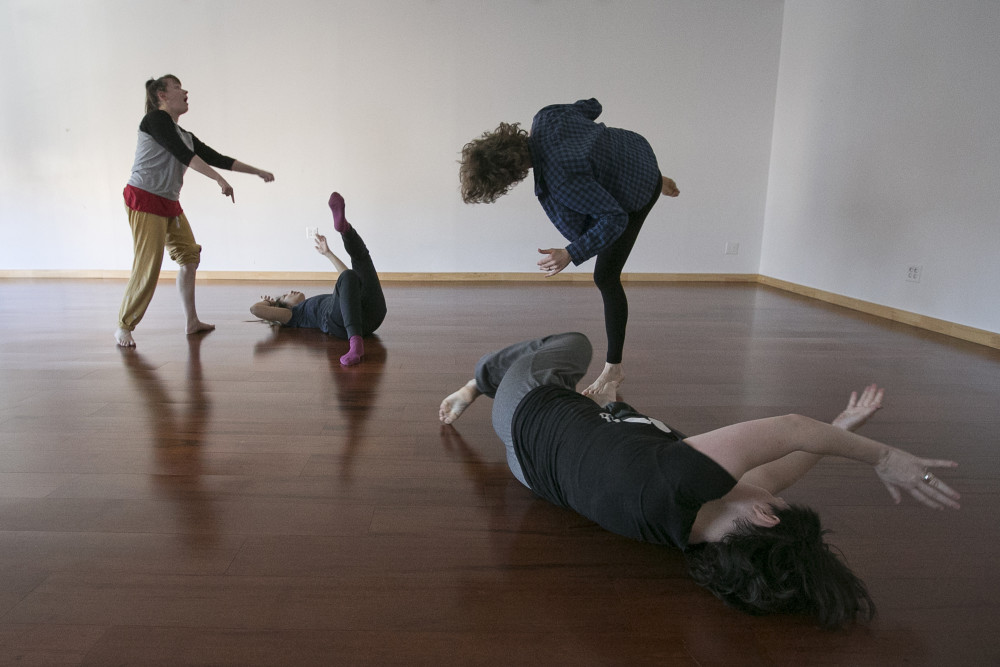By Samantha Melamed
The Philadelphia Inquirer
WWR Article Summary (tl;dr) A new artistic exhibition in Philadelphia focuses on dancer and choreographer Meg Foley’s daily devotion to dancing; specifically at 3:15pm. While Foley has been dancing daily since 2010, for this exhibit, she had three collaborators alongside her committed to creating an improvised dance at precisely 3:15 p.m. each day for six months. All of the participants documented the results in writing, photos, or video. Foley said she started the daily dance as a way to to focus and frame her attention.
PHILADELPHIA
In the middle of a conversation with a reporter, Meg Foley’s phone began to chime insistently.
“This is my least favorite context to do a 3:15, in the middle of a meeting,” she said, stifling the alarm tone. But even as she tried to continue talking, her hands were fluttering into motion. Finally, Foley excused herself and began moving with precision, scooting backward on hands and feet, tracing her arms into sweeping gestures, and unleashing a vigorous kick.
Then, with an apologetic shrug, she returned to the interview.
These moments of art and life slamming inconveniently against one another were bound to arise when Foley and three collaborators committed to creating an improvised dance at precisely 3:15 p.m. each day for six months, and documenting the results in writing, photos, or video.
All of it, the beautiful and the awkward alike, was progress toward Action is Primary, an exhibition of those documents alongside long-form, improvised dance performances, April 6 to 23 at the Icebox Project Space in South Kensington.
It’s a work about the art of sustained attention, for dancers and audience: Each performance is a double bill, and tickets are pay-what-you-can for returning visitors, encouraging audience members to come back. Members of the public also are urged to do their own 3:15 dances, and document, upload and hashtag them as part of the project.
The daily practice, Foley said, “completely changed my definition of dance. I’ve done dances in so many different places, and that feels really beautiful.”
Foley, 34, a dancer and choreographer based in South Philadelphia, began the discipline in 2010. It was a way to incorporate a daily artistic practice into her life, and to focus and frame her attention.
The time, 3:15 p.m., was necessitated by her job as a test patient for medical students.
“It was the only time of day I could guarantee that I wouldn’t be in a room with a doctor,” Foley said. “Now, I don’t know if that would stop me.”
She did the daily dances for two months straight, then six months, then two and a half years.
At first, she imagined there’d be lots of big, dancelike gestures. But she found subtle movements, small out of necessity, were dances, too.
Over time, the improvised dances became, collectively, a research project.
“It challenges the idea of a habit,” she said. “If I look within the thing I’m doing that’s a habit, there’s more information within it.”
For six months, she’s been joined in the habit by Marysia Stoklosa, who’s based in Warsaw, Poland, and Philadelphia dancer-choreographers Annie Wilson and Kristel Baldoz.
Among them, they’ve done dances in cars and on planes, in parks (where passersby occasionally gawk but often politely ignore them), while cooking, while teaching, while caring for their children, and while walking their dogs.
At 3:15 p.m. on a typical Saturday, Wilson’s tending bar. When it’s crowded, she’ll simply swing her hips while pouring a beer. If it’s empty, she’ll get up on the bar and let the dance movements flow.
Baldoz works in an office when she’s not dancing. Some days, she resorts to quiet but intricate hand movements, or to drumming her fingers on her desk.
Stoklosa, who met Foley while participating in an artistic-exchange program, tried to dance at 3:15 p.m. Eastern Standard Time for a while, but it kept her up at night. She decided to dance on Polish time instead.
She was drawn to the conflicts it presents.
“The mixing of art and life, your daily life and your artistic practice, that’s what I was interested in,” she said. “I’m at that place where I can’t recognize who is dancing anymore. It’s blending.”
Through this improvisational practice, Foley developed Action is Primary, a set of rules that create an open-ended structure that allows for infinitely varied, extemporaneous performances.
The dances are graceful, energetic, comical, and strange: There are big leaps and spins, and small frenetic gestures, and there’s no sound track but the performers’ breath and commentary.
The sprawling project also includes a series of dinner party performances, the first of which was held at W/N W/N Coffee Bar in March.
As soup was served, Foley started by proving the act of dragging a chair across a room could be construed as dance.
Then, aloud, and with her body, she measured the constraints of the room, enumerated the house rules (“Don’t stand on the bar!”) and made introductions, chanting guests’ names like the dinner party host she was, even as she whirled, crawled, and jumped through the room.
Then Stoklosa and Wilson performed a duet that began with Stoklosa stacking bar stools in the center of the room, and ended some time after she ran through the space with a handful of ice from behind the bar.
Foley plans to continue the practice, and the 3:15 dances, after the performance concludes. She hopes they’ll catch on.
A few friends and fans have already taken the challenge. She’s hoping they’ll submit proof, with the hashtag #315dance, for the Action is Primary website and exhibition.
“I want to broaden people’s ideas about their own bodies, and to show dance is not that far from your body now,” she said.
“Dance is not necessarily about a leg looking like this, or about flow. It’s about attention to your form in a specific place and time.”














































































































































































































































































































































































